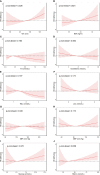Association of metabolic syndrome and the risk of bladder cancer: A prospective cohort study
- PMID: 36263231
- PMCID: PMC9574437
- DOI: 10.3389/fonc.2022.996440
Association of metabolic syndrome and the risk of bladder cancer: A prospective cohort study
Abstract
Background: Metabolic syndrome (MetS) and its components have been shown as risk factors for several solid cancers. However, current epidemiological evidence about the relevance of MetS and bladder cancer risk was limited.
Methods: We conducted a prospective cohort study of 476,986 participants with undiagnosed bladder cancer based on the UK Biobank. MetS was defined as the presence of at least three of the five selected indicators: hypertension, central obesity, raised triglyceride, reduced HDL-cholesterol, and raised fasting plasma glucose. Bladder cancer has been identified through contact with the British Cancer Registry (median follow-up time: 6.6 years). We assessed hazard ratio (HR) and 95% confidence interval (CI) through Cox proportional hazard regression after adjusting for demographic and lifestyle factors. Non-linear associations for individual MetS components were assessed by the restricted cubic spline method.
Results: During a follow-up of 3,112,566 person-years, 487 cases of bladder cancer were ascertained. MetS (HR = 1.32, 95% CI = 1.08-1.61), central obesity (HR = 1.39, 95% CI = 1.15-1.68), dyslipidemia for HDL cholesterol (HR = 1.31, 95% CI = 1.04-1.66), and hyperglycemia (HR = 1.44, 95% CI = 1.16-1.79) were associated with elevated risk of bladder cancer. Bladder cancer risk increased with the number of MetS components. In stratified analyses, MetS showed similar effects in bladder cancer independently with sex, age, cigarette and alcohol use, physical activity, and dietary factors. Higher waist circumference, BMI, fasting blood glucose, and glycosylated hemoglobin were independently associated with increased risk of bladder cancer, with no evidence against non-linearity.
Conclusion: MetS might be an independent risk factor for bladder cancer. Our findings highlighted the importance of individualized management of MetS components for preventing bladder cancer.
Keywords: bladder cancer; blood glucose; central obesity; independent risk; metabolic syndrome.
Copyright © 2022 Fang, Liu, Dai, Gao, Zeng, Sun, Zheng, Yuan, Xia and Pan.
Conflict of interest statement
The authors declare that the research was conducted in the absence of any commercial or financial relationships that could be construed as a potential conflict of interest.
Figures

Similar articles
-
Metabolic syndrome increases osteoarthritis risk: findings from the UK Biobank prospective cohort study.BMC Public Health. 2024 Jan 19;24(1):233. doi: 10.1186/s12889-024-17682-z. BMC Public Health. 2024. PMID: 38243159 Free PMC article.
-
Metabolic syndrome and its component traits present gender-specific association with liver cancer risk: a prospective cohort study.BMC Cancer. 2021 Oct 7;21(1):1084. doi: 10.1186/s12885-021-08760-1. BMC Cancer. 2021. PMID: 34620113 Free PMC article.
-
Metabolic syndrome and risk of pancreatic cancer: A population-based prospective cohort study.Int J Cancer. 2020 Dec 15;147(12):3384-3393. doi: 10.1002/ijc.33172. Epub 2020 Jul 29. Int J Cancer. 2020. PMID: 32580250
-
The Association Between Metabolic Syndrome and the Risk of Endometrial Cancer in Pre- and Post-Menopausal Women: A UK Biobank Study.J Clin Med. 2025 Jan 24;14(3):751. doi: 10.3390/jcm14030751. J Clin Med. 2025. PMID: 39941422 Free PMC article.
-
Influence of dietary cholesterol on metabolic syndrome risk in middle-aged Korean adults: using the Korean Genome and Epidemiology Study (KoGES).Lipids Health Dis. 2024 Sep 27;23(1):315. doi: 10.1186/s12944-024-02271-1. Lipids Health Dis. 2024. PMID: 39334420 Free PMC article.
Cited by
-
Metabolic syndrome increases osteoarthritis risk: findings from the UK Biobank prospective cohort study.BMC Public Health. 2024 Jan 19;24(1):233. doi: 10.1186/s12889-024-17682-z. BMC Public Health. 2024. PMID: 38243159 Free PMC article.
-
The causal relationship between osteoarthritis and bladder cancer: A Mendelian randomization study.Cancer Med. 2024 Jan;13(1):e6829. doi: 10.1002/cam4.6829. Epub 2023 Dec 15. Cancer Med. 2024. PMID: 38100139 Free PMC article.
-
Metabolic syndrome and cancer risk: a two-sample Mendelian randomization study of European ancestry.Int J Surg. 2025 Jan 1;111(1):311-321. doi: 10.1097/JS9.0000000000001926. Int J Surg. 2025. PMID: 39051916 Free PMC article.
-
Higher genetically predicted triglyceride level increases the bladder cancer risk independent of LDL and HDL levels.Sci Rep. 2024 Aug 12;14(1):18652. doi: 10.1038/s41598-024-69737-1. Sci Rep. 2024. PMID: 39134790 Free PMC article.
-
Metabolic Risk Factors at the Time of Cancer Diagnosis in Primary Care: A Cross-Sectional Study.Cureus. 2025 Jul 1;17(7):e87086. doi: 10.7759/cureus.87086. eCollection 2025 Jul. Cureus. 2025. PMID: 40747172 Free PMC article.
References
-
- Mishra V, Balasubramaniam G. Urinary bladder cancer and its associated factors – an epidemiological overview. Indian J Med Sci (2020) 0:1–10. doi: 10.25259/ijms_159_2020 - DOI
-
- van Kruijsdijk RC, van der Graaf Y, Peeters PH, Visseren FL, Second Manifestations of Adsg . Cancer risk in patients with manifest vascular disease: effects of smoking, obesity, and metabolic syndrome. Cancer Epidemiol Biomarkers Prev (2013) 22(7):1267–77. doi: 10.1158/1055-9965.EPI-13-0090 - DOI - PubMed
Grants and funding
LinkOut - more resources
Full Text Sources

